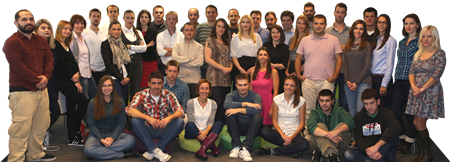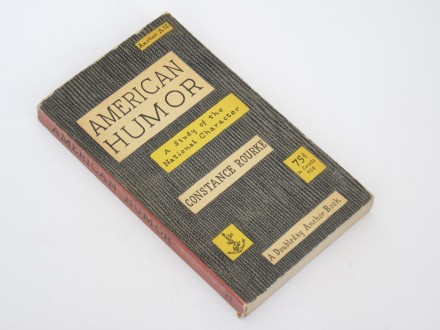American humor: A study of the national character
| Cena: |
500 din
(Predmet je prodat)
|
| Stanje: | Polovan bez oštećenja |
| Garancija: | Ne |
| Isporuka: | Pošta Post Express Lično preuzimanje |
| Plaćanje: | Tekući račun (pre slanja) Lično |
| Grad: |
Beograd-Zvezdara, Beograd-Zvezdara |
ISBN: Ostalo
Godina izdanja: 1955
Jezik: Engleski
Vrsta: Istorija svetske književnosti
Autor: Strani
Constance Rourke - American humor: A study of the national character
Doubleday Anchor Book, 1955
253 str.
meki povez
stanje: vrlo dobro, pečat na predlistu.
Anchor A12
Rourke`s work, especially American Humor, made a significant impact on the early twentieth century study of American popular culture and folk culture. From her death onwards, selections from Rourke`s works were regularly anthologized.
A biography by Joan Shelley Rubin was published in 1980.
Nevertheless, Rourke`s works and their apparent influence have faded significantly. Many of her books are out of print and recent anthologies, for instance of American Studies, do not mention her. However, Rourke continues to have some notable fans who make significant claims for her work and importance. Perhaps the most important work in this vein is Michael Denning`s book, The Cultural Front.
The famous American rock critic Greil Marcus wrote an introduction to a 2004 edition of American Humor.
Most recently, on Rourke`s birthday in 2011, Luc Sante had these words to say: `CONSTANCE ROURKE (1885-1941) died — from a slip on an icy porch — way too young. If she had finished her projected five-volume Roots of American Culture, it might have synthesized all her research into a grand Key to the American Scriptures. As it is she wrote solid if unexciting books on Davy Crockett, John James Audubon, Charles Sheeler, the Beecher family, and Lotta Crabtree, `Fairy Star of the Gold Rush`. But she also wrote American Humor (1931), fruit of prolonged and concentrated squinting into the mists, attempting to make out the first stirrings of an American culture that was free from second-guessing based on overseas models. Peering into the taverns and opera houses and faro parlors of the Jacksonian era she came to the conclusion that the primal scene occurred in humor. “Laughter produced the illusion of leveling obstacles in a world which was full of unaccustomed obstacles.” She discerned three essential figures: the Yankee peddler, the backwoodsman, and the Negro minstrel. `Each in a fashion of his own had broken bonds ... As figures they embodied a deep-lying mood of disseverance, carrying the popular fancy further and further from any fixed or traditional heritage.` She followed the three out to the frontier, riding on a wave of jokes and coinages and hoaxes and cuttings-up. The first half of the book is a breathless bravura performance; the book as a whole sits right between William Carlos Williams`s In the American Grain and Thomas Pynchon`s Mason & Dixon
Corn cobs twist your hair --
The gamecock of the wilderness --
That long-tail`d blue --
Strollers --
The comic poet --
I hear America singing --
Facing west from California`s shores --
The American --
Round up.
Nonfiction, Sociology
Plaćanje pouzećem i postnetom za sada nisu opcija.
Lično preuzimanje je isključivo na Konjarniku uz prethodni dogovor.
Hvala na razumevanju.
Predmet: 75468281











